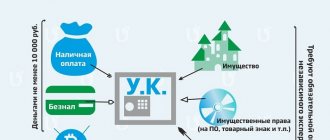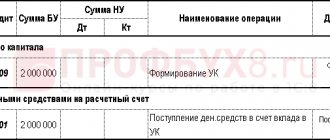Hello, Vasily Zhdanov is here, in this article we will look at the sources of the enterprise’s own funds. The enterprise's own funds are mandatory conditions for the activities of a commercial organization. Funds are generated when opening a company and are supplemented in the process of conducting business. In the event of termination of activity, the amount of equity capital determines the amount distributed among the owners - participants who were members at the time of liquidation of the enterprise.
Various sources of formation of own funds received as a result of activities are provided. Of particular importance among equity capital is the authorized capital, the reduction of which below the minimum level is not permitted by law.
Take our proprietary course on choosing stocks on the stock market → training course
When opening an organization, the source is the income of the owners - the founders of the company. Funds are contributed in cash or property at a valuation determined in accordance with the market price level. The amount of property value determined by an independent appraiser is taken into account.
Net assets of LLC
Current as of: December 18, 2021
The net assets of a company are those company's own funds that will remain with it after it has paid off all creditors. That is, it is the difference between a company's assets and its liabilities, subject to minor adjustments. Another way to determine the net asset indicator is to take the total indicator of Section III of the balance sheet “Capital and Reserves” and also adjust it by certain amounts. That is, net assets are the capital of the LLC.
General concepts
Successful business conduct is impossible without a detailed analysis of the financial and economic indicators of the economic activity of an economic entity. In order to assess the property and financial position of an organization and make the right management decisions in a timely manner, it is necessary to determine important solvency and profitability ratios. One of the key calculation indicators is the calculation of the value of net assets on the balance sheet.
The organization's net assets (NA) are the amount of funds of an economic entity, determined by calculation, which will remain at the disposal of the company after full repayment of debt obligations. In other words, the value of net assets is calculated as the arithmetic difference between the total indicators of the company’s property, material and financial assets and assumed liabilities.
Note that calculating the value of net assets on the balance sheet is mandatory for organizations. The indicator is calculated once a year based on accounting data. Indicators are reflected in the third section of the report on changes (movements) of capital; net assets are (in the balance sheet) line 360 of this reporting form.
If net assets are less than authorized capital
If your company's net assets have become less than its authorized capital, then you are obliged to reduce the authorized capital to the level of net assets and register such a decrease in the Unified State Register of Legal Entities (clause 4 of article 90 of the Civil Code of the Russian Federation, clause 3 of article 20 of the Law of 02/08/98 N 14 -FZ). That is, at least after drawing up the annual financial statements, you need to compare the authorized capital and net assets.
In addition, the following rule applies. If an LLC decides to pay dividends to participants, but as a result of accrual of dividends, the value of net assets becomes less than required, then dividends cannot be accrued in the planned amount. It is necessary to reduce the profit distributed on dividends to an amount at which the above ratio will be satisfied.
At the same time, no liability has been established for violation of the requirement for the ratio of authorized capital and net assets.
Line 1310 is
Credit balance on account 80 “Authorized capital”]
Line 1310 reflects the amount of authorized (share) capital registered in the constituent documents.
The authorized (share) capital and the debt of the founders (participants) on contributions (contributions) to the authorized (share) capital are reflected in the balance sheet as separate indicators.
For state and municipal unitary enterprises, instead of the authorized (share) capital, the authorized capital is reflected.
An increase in the authorized capital of a limited liability company (LLC) is allowed only after its full payment.
Net assets
Net assets are one of the most important indicators that characterize the financial condition of an organization. Not only the assessment of the company’s performance, but sometimes the very existence of the business depends on their amount. Let's look at why net assets are needed and how this indicator is calculated.
What are net assets and how to calculate them
Let's consider this theoretical situation. The owner of the company decided to stop his business. He fired the workers, paid them the settlement, sold the buildings and equipment, sold the remaining raw materials and products (goods), received all accounts receivable, and also fully paid off with suppliers and the budget.
The money that will remain at the disposal of the business owner after all these operations is the net assets (NA) of the company.
The procedure for calculating net assets was approved by order of the Ministry of Finance of the Russian Federation dated August 28, 2014 No. 84n.
NA = (A – DZU) – (O – DBP)
A – company assets (line 1600 of the balance sheet)
DZU – receivables of the founders for contributions to the authorized capital;
О – company liabilities (sum of lines 1400 and 1500 of the balance sheet);
DBP – separate income of future periods.
In practice, situations when it is necessary to use the corrective indicators DZU and DBP are rare. Therefore, in most cases the formula looks like
HA = A - O = page 1600 – page 1400 – page 1500 = page 1300
Those. In general, the company’s net assets are the result of Section III of the balance sheet, “Capital and Reserves.” It consists of:
- Authorized capital (AC).
- Retained earnings (RE).
- Reserve and other similar funds (RF).
- Additional capital
- Amounts of revaluation of non-current assets.
- The value of shares in the management company owned by the company itself.
Most small LLCs usually only use the first three positions, because... They rarely use other types of sources of funds.
CHA = UK + NP + RF = line 1310 + line 1370 + line 1360
What do net assets show?
As can be seen from the previous section, the main factor that affects the value of net assets is retained earnings. After all, changes to the management company rarely occur, and reserve funds are also mainly formed from profits and, moreover, not by all LLCs.
Therefore, an increase in net assets in most cases indicates that the company is operating consistently at a profit. This is a positive factor in assessing a business both for its owners and for external users - counterparties, banks, potential investors.
Each LLC is obliged to calculate its net assets at least once a year and include this information in its financial statements (Clause 3, Article 30 of Law No. 14-FZ dated 02/08/1998).
The law also provides for other situations when it is necessary to take into account the size of net assets. We will talk about this in more detail in the following sections.
Net assets in unprofitable activities
If the company is operating at a loss, then the balance sheet line 1370 may become negative. Therefore, the formula for calculating net assets will take the form
NA = UK + RF – NU (uncovered loss)
If the reserve fund is less than the accumulated loss (or is absent altogether), then the net assets will become less than the authorized capital.
In this case, the management company will no longer be able to perform one of its main functions - to guarantee the company’s counterparties the fulfillment of their obligations to them. After all, after all the calculations, the business owners will actually have at their disposal an amount less than the amount of the authorized capital indicated in the balance sheet.
If the amount of the company’s net assets remains below the authorized capital for two years in a row, then the organization must reduce the authorized capital to the amount of net assets within 6 months. The first year of work “does not count.” Thus, the law gives a new business the opportunity to develop without imposing requirements at the initial stage of activity.
But the Criminal Code can only be reduced to a certain limit. In general, its minimum amount for an LLC is 10 thousand rubles. If net assets fall below this amount, then the owners must decide to liquidate the organization. For this purpose, 6 months are also allotted after the end of the two-year period of reduction in the value of net assets (clause 4 of Article 30 of Law No. 14-FZ).
Net assets in settlements with founders
There are two main situations when an operating LLC makes payments to its members:
- Dividend payment.
- Payment of the actual value of the share when a participant leaves the company.
In both of these cases, the size of net assets must be taken into account.
When the founders intend to use the profit received or part of it to pay dividends, it is necessary, in particular, to comply with the following rules (Article 29 of Law No. 14-FZ):
- The size of net assets should not be less than the sum of the authorized capital and reserve funds at the time of the decision or actual payment.
- The amount of net assets should not fall below this amount after payment of dividends.
A participant who leaves the company must receive a portion of the net assets corresponding to his share. The net asset value is determined based on the financial statements for the previous year.
The rule here is similar to the situation with the payment of dividends. Payment of the actual value of the share should not result in the company's net assets being less than its authorized capital. Otherwise, the organization must first reduce the capital, and only then make settlements with the exiting participant.
Since the law has established restrictions for reducing the authorized capital, the maximum amount that a participant can receive upon leaving the LLC is also limited. It is equal to the difference between the current size of net assets and the minimum size of the capital company (Clause 8, Article 23 of Law No. 14-FZ).
How to quickly increase your net worth
The “normal” way to increase net worth is to make a profit. All retained earnings fall into section III of the balance sheet and “automatically” increase net assets. But what to do if there is no profit, or its amount is not enough?
Then the founders will have to resort to other ways to increase net assets:
- Increase the authorized capital.
- Pay off debt on deposits in the management company.
- Make contributions to the company's property without increasing the authorized capital.
- Conduct a revaluation of assets.
- Write off accounts payable.
The best of the options listed is a contribution to property. It is available to every organization, does not require complex registration and, in most cases, does not entail tax consequences.
An increase in the charter capital requires amendments to the Charter and state registration. Repayment of debt on contributions to the authorized capital is possible only if such debts exist, i.e. This option is not suitable for every company.
The last two methods are also not available to everyone. After all, not every organization has overdue accounts payable or assets for revaluation in sufficient quantities. In addition, when writing off a “creditor”, you will have to pay income tax, and an increase in the value of fixed assets can lead to an increase in the taxable base for property tax.
Conclusion
Net assets are the most important financial indicator, the growth of which indicates the efficient operation of the business. Net assets are generally formed from the authorized capital, reserve funds and retained earnings.
The law does not allow the reduction of net assets to an amount not exceeding the amount of the authorized capital. This rule must be followed both within the framework of current activities and in settlements with the founders.
If the accumulated profit is not enough, then the company owners can invest additional funds in the authorized capital or property of the LLC. Also, the growth of net assets can be achieved through accounting operations: writing off accounts payable and revaluing assets.
The simplest and most profitable way for founders to support a company in order to increase its net assets is to contribute to the company’s property without changing the authorized capital.
Section 3 refers to the liability side of the balance sheet and contains digital indicators characterizing the capital and reserves of the organization, namely:
· Authorized capital.
· Own shares purchased from shareholders.
· Revaluation of non-current assets.
· Extra capital.
· Reserve capital.
· Retained earnings (uncovered loss).
Authorized capital (share capital, authorized capital, contributions of partners) (line 1310) - indicates the amount of the authorized capital of the organization at the end of the reporting period, fixed in the constituent documents.
The balance sheet indicators on line 1310 do not contain information about changes in capital.
The explanation for line 1310 “Authorized capital (share capital, authorized capital, contributions of partners)” of the balance sheet is the Statement of Changes in Capital.
Please note: The indicator in line 1310 of the balance sheet must correspond to the indicator in the “Authorized Capital” column of the line “Capital Amount as of December 31, 2013.” (line 3300) Statement of changes in capital.
Own shares purchased from shareholders (line 1320) - indicates the amount of the debit balance in account 81 “Own shares (shares)” at the end of the reporting period.
Own shares/shares purchased from shareholders/participants are reflected in the financial statements in the amount of actual costs for their redemption, regardless of the nominal value.
Please note: The indicator in line 1320 of the balance sheet must correspond to the indicator in the column “Own shares purchased from shareholders” of the line “Capital value as of December 31, 2013.” (line 3300) Statement of changes in capital.
This indicator is reflected in parentheses.
Revaluation of non-current assets (line 1340) – the credit balance is indicated in account 83 “Additional capital”, in terms of revaluation of non-current assets, at the end of the reporting period, taking into account the revaluation carried out as of December 31, 2013.
Please note: Revaluation of fixed assets is carried out by recalculating their residual or current (replacement) value (if this object was revalued previously), and the amount of depreciation accrued for the entire period of use of the object (clause 15 of PBU 6/01).
Revaluation of intangible assets is carried out by recalculating their residual value (clause 19 of PBU 14/2007).
Additional capital (without revaluation) (line 1350) – indicates the amount of the credit balance in account 83 “Additional capital” at the end of the reporting period, minus the amount of the credit balance formed in connection with the revaluation of assets.
Amounts of additional capital include, for example, the excess of the selling price of shares/shares over their nominal value.
Reserve capital (line 1360) – indicates the amount of the organization’s reserve capital at the end of the reporting period.
This line reflects the amounts of reserve (and other) funds formed in accordance with the constituent documents and provisions of the current legislation.
In accordance with clause 1 of Article 30 of Law No. 14-FZ “On Limited Liability Companies”, the Company may create a reserve fund and other funds in the manner and in the amounts established by the company’s charter.
In accordance with clause 1 of Article 35 No. 208-FZ “On Joint-Stock Companies,” a reserve fund is created in the company in the amount provided for by the company’s charter, but not less than 5 percent of its authorized capital.
The reserve fund of the company is formed through mandatory annual contributions until it reaches the size established by the charter of the company.
The amount of annual contributions is provided for by the company's charter, but cannot be less than 5 percent of net profit until the amount established by the company's charter is reached.
The company's reserve fund is intended to cover its losses, as well as to repay the company's bonds and repurchase the company's shares in the absence of other funds.
The reserve fund cannot be used for other purposes.
We recommend that the procedure for creating reserve (and other) funds, as well as the procedure for contributions to these funds, be fixed in the accounting policy for accounting purposes and reflected in the explanatory note to the statements.
Please note: The indicator in line 1360 of the balance sheet must correspond to the indicator in the “Reserve capital” column of the line “Capital value as of December 31, 2013.” (line 3300) Statement of changes in capital.
Retained earnings (uncovered loss) (line 1370) – indicates the amount of retained earnings (uncovered losses) reflected at the end of the year in account 84 “Retained earnings (uncovered loss)”.
Please note: The indicator in line 1370 of the balance sheet must correspond to the indicator in the column “Retained earnings (uncovered loss)” of the line “Capital value as of December 31, 2013.” (line 3300) Statement of changes in capital.
The indicator on line 1370 is indicated without brackets if the balance is positive (when reflecting retained earnings) and in parentheses if the result is negative (when reflecting uncovered losses).
Total for section III (line 1300) – indicates the total amount of the organization’s equity capital at the end of the reporting period.
Line 1300 = line 1310 + line 1320 + line 1340 + line 1350 + line 1360 + line 1370.
Please note: The indicator in line 1300 of the balance sheet must correspond to the indicator in the “TOTAL” column of the line “Capital value as of December 31, 2013.” (line 3300) Statement of changes in capital.
In the article we will determine which property, material and monetary values of an economic entity can be classified as net assets. We will provide a calculation formula and tell you how to analyze and improve the indicators.
Details
The authorized capital of a legal entity is the initial provision of the organization’s activities by contributing funds (property, securities) by owners or shareholders.
Note from the author! The size of the authorized capital undergoes the procedure of official state registration and is displayed in the constituent documentation of the company; the data in the financial statements and documents must be identical.
Depending on the organizational and legal form of legal entities, a certain procedure for the formation of the initial property of the organization is established:
- JSC: authorized capital - the nominal value of shares purchased by shareholders.
The minimum amount for a PJSC is 100 thousand rubles, a non-public company is 10 thousand rubles. - LLC: authorized capital - the initial amount of funds contributed by the founders.
Minimum amount: 10 thousand rubles, funds must be deposited within 4 months from the date of state registration of the company.Note from the author! The initial deposit can be formed not only in cash, but also in tangible assets (fixed assets, goods, etc.), securities. When making a contribution with property, its value must be assessed by an independent appraiser.
- State and municipal unitary enterprises: the formed fund is the minimum amount of initial property that ensures the interests of potential creditors of the organization.
The minimum amount of the fund for a government institution: not less than 5,000 minimum wages established by the government on the date of registration.The minimum amount of the fund for municipal enterprises: not less than 1000 minimum wages established by the government on the date of registration.
Note from the author! From January 1, 2021, the Federal Law established the minimum wage at 9,489 rubles. Regions have the right to apply federal laws to determine the minimum wage for employees. From May 1, 2021, the minimum wage will be 11,163 rubles.
Line 1310 of the balance sheet of the financial statements belongs to the Capital and liability reserves section of the balance sheet: information on the state of the authorized capital of the organization as of December 31 of the current year, the previous year and the previous one is displayed here. The data must completely match the registered constituent documentation.
Note! In the financial statements, the amount of the authorized capital is reflected in full, regardless of whether it has been paid at the moment.
Net assets of the enterprise on the balance sheet
The cost of NA is calculated based on the results of the reporting period - a year or intermediate periods - a quarter, half a year, 9 months. The determination of net assets on the balance sheet is made by subtracting the debts of the liability section from the asset, applying adjustments to off-balance sheet accounts, debts of the founders/shareholders and income for future periods.
The calculation formula was approved by the Ministry of Finance of the Russian Federation in order No. 84n dated August 28, 2014 and is described in detail in a separate article. To calculate the size of an organization's net assets according to financial statements, the following mathematical algorithm is used:
NA = (line 1600 – Debts of the founders as part of receivables) – (line 1400 + line 1500 – Income of future reporting periods).
The net asset indicator is entered into the form for calculating the value of the net assets developed by the enterprise. It is allowed to use the form approved by the Ministry of Finance and the Federal Securities Commission in order No. 10n dated January 29, 2003. The result obtained may be positive or not. Negative net assets indicate unprofitable operations and possible insolvency of the company in the near future; they show the complete dependence of the business on external investments and loans. The exception is newly opened companies that have not yet received income.
Important! Repeated reductions in the level of asset capital below the limit value (size of authorized capital) may become a prerequisite for the forced liquidation of the enterprise in accordance with the requirements of Law No. 208-FZ of December 26, 1995 (Article 35, paragraph 11).
Analysis of indicators
Having completed the arithmetic calculations, we move on to analyzing the result obtained. With a positive amount of net assets in the balance sheet, we can conclude that the company is profitable and has high solvency. And, accordingly, the higher the indicator, the more profitable the enterprise.
Negative net assets are an indicator of the low solvency of an enterprise. In other words, a company with a negative NAV will most likely go bankrupt soon; the company will simply have nothing to pay off its debts. However, in such a situation, exceptional circumstances must be taken into account. For example, the company has just been formed and has not yet covered its costs, or the company received a large loan for expansion.
An increase in net assets can be achieved by increasing the authorized, reserve or additional capital or by reducing the founder’s debts to the enterprise.
Net assets of a joint stock company
Net assets in the balance sheet of the joint-stock company, line 3600 section. 3 statements of changes in capital are calculated according to the formula used by LLCs and enterprises of other forms of ownership. Joint-stock companies calculate the NAV before paying dividends to shareholders, when a shareholder leaves the business, to determine the ratio between the authorized capital and the amount of net assets, in the case of purchasing placed shares or when repurchasing shares owned by the company.
What is a comparative analytical balance sheet of net assets?
A similar analysis is carried out to study the dynamics of changes in the financial condition of the enterprise. At the same time, absolute and specific ratios are calculated at the beginning/end of the reporting period for individual indicators and the overall picture of the state of affairs in the organization is determined. The calculations use various indicators, formulas and coefficients. For example, the method for determining the value of own working capital (SOC):
SOS = Own sources (section 4 of the balance sheet) – Non-current assets (section 1 of the balance sheet).
Conclusion - to find out where the net assets are on the balance sheet, it is necessary to calculate the amount of the company's own funds, not encumbered with liabilities. The cost is determined in monetary terms as of the latest reporting date based on accounting data.
Line 1300 balance
What are they made of?
They include two sections - current and non-current, grouped in ascending order, that is, by the level of liquidity of each indicator.
The structure, in accordance with Order No. 66n dated 07/02/2010, is presented in the table:
| Name | Assets on balance sheet - line | Characteristic |
| Non-negotiable | ||
| Intangible | 1110 | Patents, licenses, organizational expenses. |
| Research and development results | 1120 | Inventions, computer software. |
| Search intangible assets | 1130 | Used natural resources and subsoil resources. |
| Search MA | 1140 | |
| OS | 1150 | Buildings and structures, machinery, equipment, land. |
| Profitable investments in MC | 1160 | Property for leasing. |
| Financial investments | 1170 | Investments, participation in the authorized capital of other companies, loans. |
| Deferred tax | 1180 | Account 09 is part of the deferred income tax, which is aimed at reducing the income tax payable in subsequent reporting periods (using PBU 18/02). |
| Other VBA | 1190 | Funds and investments not included in other groups. |
| Negotiable | ||
| Reserves | 1210 | Finished products, raw materials, supplies. |
| VAT on purchased assets | 1220 | The amount of “input” VAT that was not reimbursed from the budget. |
| Accounts receivable | 1230 | The assets of the balance sheet reflect receivables for which payments are expected within or more than 12 months after the reporting date. |
| Financial investments other than cash equivalents | 1240 | Investments in securities of other companies, interest-bearing bonds of state and local loans. |
| Cash and equivalents | 1250 | The total amount of cash equivalents held by an organization. |
| Others | 1260 | OA not included in other groups. |
The totals reflected in line 1600 must correspond to the total result in line 1700.
An organization's equity capital refers to the totality of funds available to the company. Or rather, funds belonging to the participants of the organization. How is the amount of an organization’s equity capital determined based on the balance sheet data?
Accounting statements of small businesses 2021: sample
Let’s fill out the reporting of a small enterprise, LLC Giatsint, which uses the simplified tax system “Income” using the example:
The company's balance sheet for the year:
| Account number | Balance at the beginning of the period | Revolutions | Closing balance | |||
| D/t | K/t | D/t | K/t | D/t | K/t | |
| 90,1 | ||||||
| 90,2 | ||||||
| 90,3 | ||||||
| 91,1 | ||||||
| 91,2 | ||||||
| total | ||||||
Let’s assume that the interest paid for the loan amounted to 5,000 thousand rubles, the company had no other expenses, and the calculated tax according to the simplified tax system amounted to 69,000 thousand rubles.
Let's look at filling out simplified financial statements for 2017. Observing the principle of equivalence of both parts, we enter the values in the lines:
| Line | Account balance | In amounts |
| D/t (01 + 08) – K/t 02 | 400000 + 157000 – 240000 = 317000 | |
| D/t 58 | ||
| D/t (10 + 41 +44) | 18000 + 61000 + 5100 = 84100 | |
| D/t (50 + 51 + 52) | 42200+ 292600 + 50000 = 384800 | |
| D/t (62 + 71 + 76) | 111900 + 67000 = 178900 | |
| Asset Line Sum | 317000 + 85000 + 84100 + 384800 + 178900 = 1049800 | |
| K/t (80 + 82 + 83 + 84) | 500000 + 23000 + 32000 + 202600 = 757600 | |
| K/t 66 | ||
| K/t (60 + 68 + 69+ 70) | 9500 + 30000 + 30000 + 57700 = 127200 | |
| Sum of liability lines | 757600 + 165000 + 127200 = 1049800 |
The second form of simplified accounting financial statements, a sample of which is presented, is the OFR. The algorithm for filling it in the table:
| Line | What is it made up of? | In amounts |
| Kr. turn 90/1 – D. turn 90/3 | 300000 – 32000 = 268000 | |
| D.turn 90/2 | ||
| Kr. turn 91/1 – D.turn 91/2 | 100000 – 18000 = 82000 | |
| % on loans | ||
| Tax according to the simplified tax system | ||
| Calculation | 268000 – 100000 + 82000 – 5000 – 69000 = 176000 |
This is the procedure for filling out financial statements for small businesses. If necessary or desired, companies fill out other forms, but only these two are required.
Comparison with old format codes
Previously, the line code consisted of three digits. At the moment, only those codes that are specified in a special appendix to Order 66 of the Ministry of Finance are being considered. This is app #4 which sets up four digit codes for use.
The encoding of the old form differs from the new one only in that the list of these lines changes, their encoding turns into a four-digit indicator, and the detail of the information provided in the balance sheet changes slightly. The row assignments remain the same.
Instructions for filling out simplified financial statements
Before we figure out how to fill out a simplified balance sheet, let’s consider what indicators are involved in forming the values of each line of the balance sheet. Controlling authorities require the presentation of forms with line numbering, so we will fill out the balance using the applicable codes.
| Line code | Includes account balance | |
| D/t | K/t | |
| Assets | ||
| 01, 07, 08 | ||
| 04, 08 investment in non-current assets, 09, 58 | ||
| 10,20,41,43,44 | ||
| 50,51,52,57 | ||
| 58, 60, 62, 68, 69, 71, 71, 73, 75, 76 | ||
| 1600: Total balance sheet asset | sum of rows | |
| Passive | ||
| 80, 82, 83, 84 | ||
| 60,62,68,69,70,71,73,76, 75 s/account for payment of income | ||
| 77,96,98 | ||
| 1700: total balance sheet liability | sum of rows | |
The values of lines 1600 and 1700 must be the same, i.e. the balance between assets and liabilities must be maintained. The equivalence of both parts is one of the criteria for correctly filling out the form.
Continuing to master the procedure for filling out simplified financial statements in 2021, let us turn to Form 2 - FRF, which has its own design features - the values of income and expenses from sales are recorded without brackets, other expenses - in brackets. This report also focuses on line numbering:
| Values | Line no. | Account turnover | |
| according to D/t | according to K/tu | ||
| Revenue (excluding VAT and excise taxes) | 90/3 s/sch "VAT" | 90/1 s/c "Sales" | |
| Expenses for ordinary activities | 90/2 from cost, commercial and administrative expenses accounts | ||
| Etc. income | 91 s/ch VAT | 91 s/ac of other income | |
| % payable | The amount of interest paid on loans provided | ||
| Etc. expenses | Debit. turnover 91 ac/account of other expenses – line 2330 | ||
| Taxes | If the company pays: -NNP, then enters in the line the amount of page 180 of the 2nd sheet of the NNP declaration; - USN “Income”, then calculates the difference in the values of lines 133 and 143 sections. 2.1.1 tax declarations under the simplified tax system; -STS “Income reduced by expenses”, then the amount of line 273 section. 2.2 declarations; — UTII, the amount due for payment | ||
| Net income (loss) | The value is derived using the formula: Page 2110 – page 2120 + page 2340 – page 2350 – page 2410 A positive result means profit (indicated without parentheses), a negative result means loss (in parentheses). | ||






